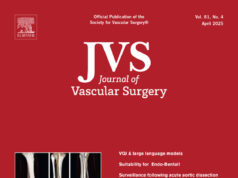
A review evaluating the results of thoracic endovascular aortic repair (TEVAR) following acute type B aortic dissection suggests most patients have less than 2cm of proximal healthy descending thoracic aorta. In patients treated for complicated acute type B aortic dissection, zone 2 TEVAR is associated with a lower need for aortic reintervention and aortic-related adverse events than Zone 3 TEVAR, researchers behind the study found.
Further, patients may benefit from a more aggressive proximal landing zone with similar perioperative morbidity when zone 2 TEVAR is done with left subclavian artery revascularization, according to senior author Jean Panneton, MD, chief of vascular surgery at Eastern Virginia Medical School in Norfolk, Virginia. The study was published in the Journal of Vascular Surgery (JVS) this month.
“TEVAR for the treatment of complicated acute type B aortic dissection has been shown to have favorable outcomes compared to both open aortic repair and medical therapy,” he said. “However, the optimal approach for this therapy, including timing, coverage length and landing zone remains to be fully elucidated.
“The aim of this study was to evaluate and compare postoperative outcomes and late aortic-related adverse events in patients undergoing TEVAR for complicated complicated acute type B aortic dissection with proximal endograft deployment in landing zones 2 versus 3.”
Panneton and colleagues performed a retrospective chart review, from a single center, of adult patients who underwent TEVAR for complicated acute type B aortic dissection within six weeks of diagnosis. The chart review was for patients treated from January 2008 to December 2018. Reviewers excluded patients with prior type A repair and connective tissue disorders.
Some 83 patients were evaluated and separated into two groups based on landing zone: zone 3 (35), zone 2 (48), with the latter subdivided between left subclavian artery revascularization (38) vs. coverage without revascularization (10). Imaging evaluation revealed that only 11% of the study population had more than 2 cm of healthy descending aorta to land the TEVAR. Overall 30-day survival (88%) did not differ between the groups (p=0.6), with zone 3 at 89%, zone 2 covered at 80% and zone 2 revascularized at 90%. The postoperative spinal cord ischemia rate was 3.7%—2.7% for zone 2 revascularized, 0% for zone 3, and 20.0% for zone 2 covered (p=0.012).
Subsequent retrograde aortic dissection was observed in three patients (4%)—one zone 2 and two zone 3 patients. The overall aortic reintervention rate at 36 months after TEVAR differed significantly between the groups (p=0.25), with zone 3 at 31% and zone 2 at 10%
“The proximity of the primary tear to the origin of the left subclavian artery can make it difficult to achieve a secure 2cm landing zone of healthy aorta without coverage of one of the aortic arch branch vessels. Notably, 90% of our study patients had a less than 2cm proximal landing zone,” said Panneton. “Factors which may contribute to the better outcomes observed for the zone 2 patients may include a landing zone that is further away from the aortic pathology and is more optimal in terms of seal given it is less curved than in zone 3. Additionally, our low rate of retrograde dissection may be related to avoiding proximal endograft oversizing (>10%) and post-deployment balloon molding.”
Many technical details must be considered to achieve excellent outcomes in this difficult patient population, according to JVS editors. “Strong consideration for landing the TEVAR in zone 2, including subclavian artery revascularization, appears important to better long-term outcomes.”












